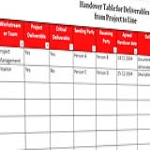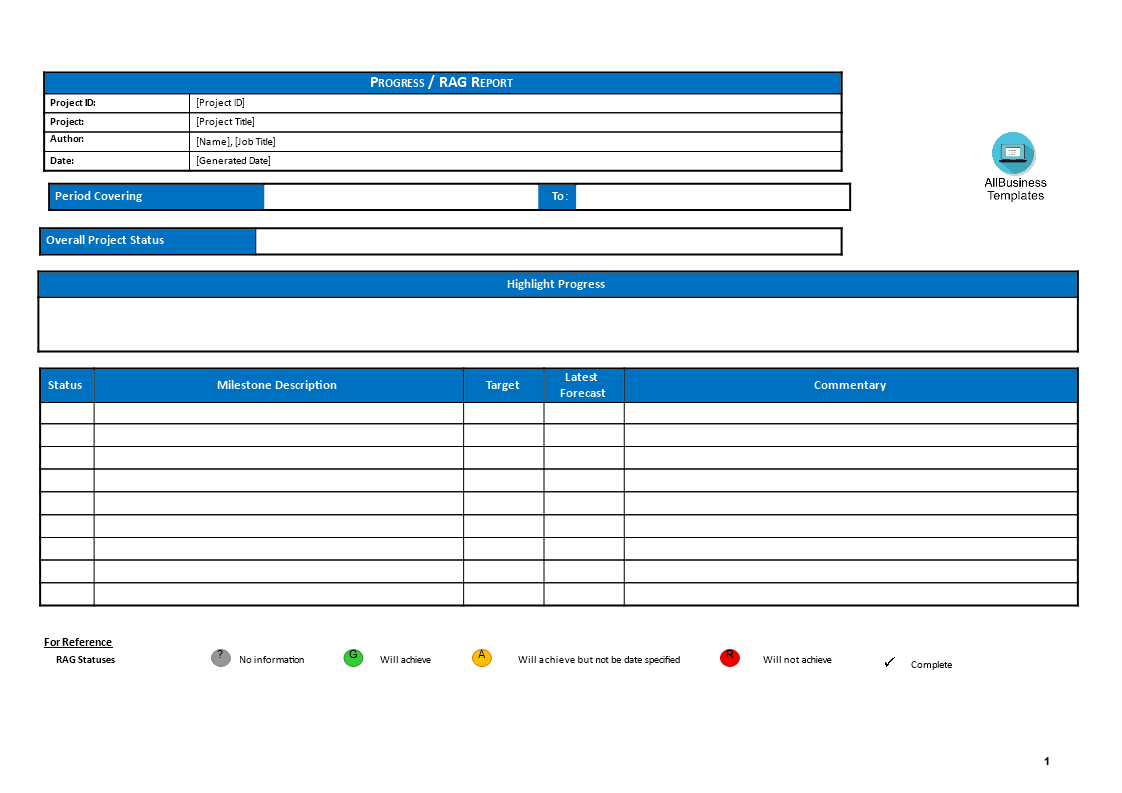Basic Project Progress Report
Sponsored Link免费模板 保存,填空,打印,三步搞定!

Download Basic Project Progress Report
微软的词 (.docx)免费文件转换
其他可用语言:
- 本文档已通过专业认证
- 100%可定制
- 这是一个数字下载 (41.93 kB)
- 语: English
Sponsored Link
How to report on your project to your superiors and other stakeholders? Do you need a very plain project progress report? Download our free professional Project Progress Report Template now.
A project progress report compares actual status and past achievements in a period, and to date, against the planned accomplishments within 1 project. A project typically has a beginning and an ending, and within that, a timeline can be visualized that keeps track of the achievements. Besides, it has milestones, activities, costs over time, RAG status, test points, targets, and forecasts, etc. A progress report describes how the actual project is fitting to the original timeline, with costs and milestones that may vary from the planned original.
A Basic Project Progress Report is a valuable tool for several reasons:
- Communication: It serves as a clear and concise means of communication among project stakeholders, including team members, management, clients, and other interested parties. It keeps everyone informed about the project's status, achievements, and challenges.
- Transparency: A progress report promotes transparency by providing an accurate and up-to-date picture of the project's progress. This transparency can help build trust among stakeholders.
- Accountability: It holds team members and project leads accountable for their responsibilities and deadlines. When progress is documented and shared, it becomes easier to identify and address any delays or issues promptly.
- Decision-Making: Project managers and stakeholders can use progress reports to make informed decisions. By reviewing project status, they can adjust resources, timelines, or strategies as needed to ensure the project stays on track.
- Problem Identification: Progress reports highlight potential problems or roadblocks early in the project lifecycle. This allows teams to address issues proactively rather than waiting until they become more significant and costly to resolve.
- Resource Allocation: By examining the progress and resource utilization in a project, organizations can allocate resources more efficiently, ensuring that teams have the necessary support to complete their tasks.
- Risk Management: Progress reports help in identifying and managing project risks. They allow stakeholders to assess whether the project is progressing as expected and if any risk mitigation measures need to be implemented.
- Documentation: A progress report serves as a historical record of the project's evolution. It can be valuable for future reference, audits, or when analyzing similar projects for lessons learned.
- Motivation: Regularly sharing progress updates with the team can boost morale and motivation. Recognizing achievements and milestones can provide a sense of accomplishment and encourage continued effort.
- Client Satisfaction: For client-facing projects, progress reports demonstrate a commitment to transparency and client involvement. Clients appreciate being informed about project status and can provide feedback or adjust their expectations as needed.
- Legal and Contractual Obligations: In some cases, project progress reports may be required by contracts or legal agreements. Failing to provide these reports could result in contractual breaches or disputes.
- Continuous Improvement: By reviewing past progress reports, organizations can identify areas for improvement in project management processes, resource allocation, and overall project execution.
For those individuals, who make the biggest impacts, have, what we call, a "high-performance mindset” and are often using professional written templates to achieve their goals faster! This is a very basic matrix in MS Word, which enables you to provide weekly updates to the involved stakeholders on the project progress that is made. Start using it, and impress your boss or colleagues with the way you are handling your projects. Typically, most progress reports will be structured along with the following items:
- Project ID;
- Project title;
- Author(s);
- Date;
- The period covering start and due date;
- Overall project status description (including a RAG Status);
- Highlight Progress;
- Status;
- Milestone description;
- Target;
- Latest forecast.
Check out this video of a project progress report or check out other Project Status Report templates (Word and Excel project status report examples).
Download this report template now, fill-In the blanks, print …and done!
DISCLAIMER
Nothing on this site shall be considered legal advice and no attorney-client relationship is established.
发表评论。 如果您有任何问题或意见,请随时在下面发布
相关文件
Sponsored Link




